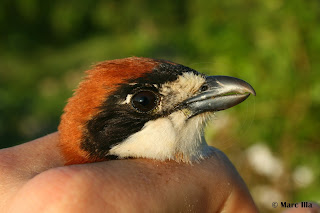After being ringing in l'Illa de l'Aire, in Menorca, you will probably feel weird when you arrive at home. Living in that small, uninhabited and wild island you will feel in great harmony with wildlife. I have to reccomend everybody interested in to spend there some days and enjoy all of that things.










I have to talk about some great people that makes tha ringing campaign possible: Raül Escandell, J.J.Carreras, Santi Catchot, Xavi Méndez, Joan Florit, Emili Garriga, Alicia Pioli... I'm very grateful with them for his high hospitality and better personality. A big hug for everyone!
Last year I visited for first time the island in April. This time, my visit was in May, so migrants were quite different and I could enjoy some different species than the previous year. If I want to talk about all things I learnt and about all species that I trapped, this post would never end. So... let's talk about Balearic subspecies, my new birding obsession.
Hardly ever, islands have lots of interesting species, subspecies or populations that are known to be endemics or simply specials. Everybody knows the Blue Chaffinch (Fringilla teydea) or Giant Turtles from Galapagos. Balearic islands are not the exception, and probably most 'popular' endemics are the Balearic Warbler (Sylvia balearica) and the Balearic Shearwater (Puffinus mauretanicus). But this time, I prefer to talk about subspecies.
Balearic Woodchat Shrike (Lanius senator badius) breeds in Balearic Islands, Corsica and Sardinia. It differs from the nominate form in the following main characters:
- Size: bigger than other subspecies, hardly ever wing lenght > 100 mm.
- Big and strong bill.
- Small or absent white patch on base of primaries with closed wing.
- Narrow black patch on forehead.




 |
| Look at the white patch on the basis of primaries, some badius have a small patch if the wing is slightly open. |
I'm actually careful about identification in the field, without trapping the bird, so I never consider as 100% sure an identification of a badius without measurements (always talking about observations out of the breeding area). This subspecies is not a very rare bird in Catalonia and in south France, where every year some birds are detected.
Moltoni's Warbler (Sylvia (cantillans) moltonii) breeds in Balearic Islands and also Corsica and Sardinia. Its identification in the field can be quite tricky if the bird doesn't call (easy feature to recognise that subspecies, because of the similarity with the Winter Wren Troglodytes troglodytes call). Only males could be recognisable 100% sure (females are usually unidentifiable also in hand), and the main character is the plumage colouring: salmon-pink on breast, without any traces of orange, and a bluish-grey on upper parts. Also, the very extensive (usually complete) prebreeding moult can also help to a correct ID: birds in spring have a very fresh plumage.

 |
| Look at the remiges borders, the bird had moulted primaries but has retained some secondaries. |

Moltonii is also not a very rare bird in Catalonia and southern France in spring, but observers have to be careful with identification, specially if the birds is not trapped during a ringing session. Light fools, and colours could be tried erroneously.
Balearic Spotted Flycatcher (Muscicapa striata balearica) breeds only in Balearic Islands and is probably the most recognisable balearic subspecies. In the field, the pallid upper parts and traces of white on the crown usually attracts the attention of the observer. In hand, these subspecies is smaller than the nominate one, but the best criteria is the position of the 2nd primary feather with the wing closed, that it rests between de 5th and the 6th in balearica and between the 4th and the 5th in striata. Also, balearica shows clear white in breast and underwing coverts, that is a 'dirty' white in striata.




As I said before, usually a correct identification could be very tricky. I have to reccomend to be careful with 'difficult ID birds' and ask for opinions to other birders when you have any doubt.




 |
| Left bird: balearica. Right bird: striata. |

Hi MArc
ReplyDeleteSuper interesting. Any idea how to separate Balearic Spotted Fly from Corsican/Sardinian ones though?
Pierre
Hi Pierre!
ReplyDeleteThank you for your comment!!
Actually I've never seen a tyrrhenica and I think there are not much information about this subspecies, but my understanding is that a tyrrhenica should be very similar to a balearica in measurements and general plumage colouring, but without the clearly marked white crown. As in balearica, the major part of body and wing feathers are brownish, but tyrrhenica seems to show an interesting uniform greyish head... Also, primary projection is quite short in both subspecies and I would not surprised if tyrrhenicas had the second primary between the 5th and 6th ;)
I really want to come to Corsica/Sardinia and trap some birds!!
Marc
Hi Marc. FYI there is an upcoming paper in Journal of Avian Biology, that recommends splitting Muscicapa s. tyrrhenica and M.s. balaerica away from Spotted Flycatcher .... I found your blog searching for info about the visual difference - and the photo with the two perhaps upcoming species is nice info. Preben Clausen
ReplyDelete